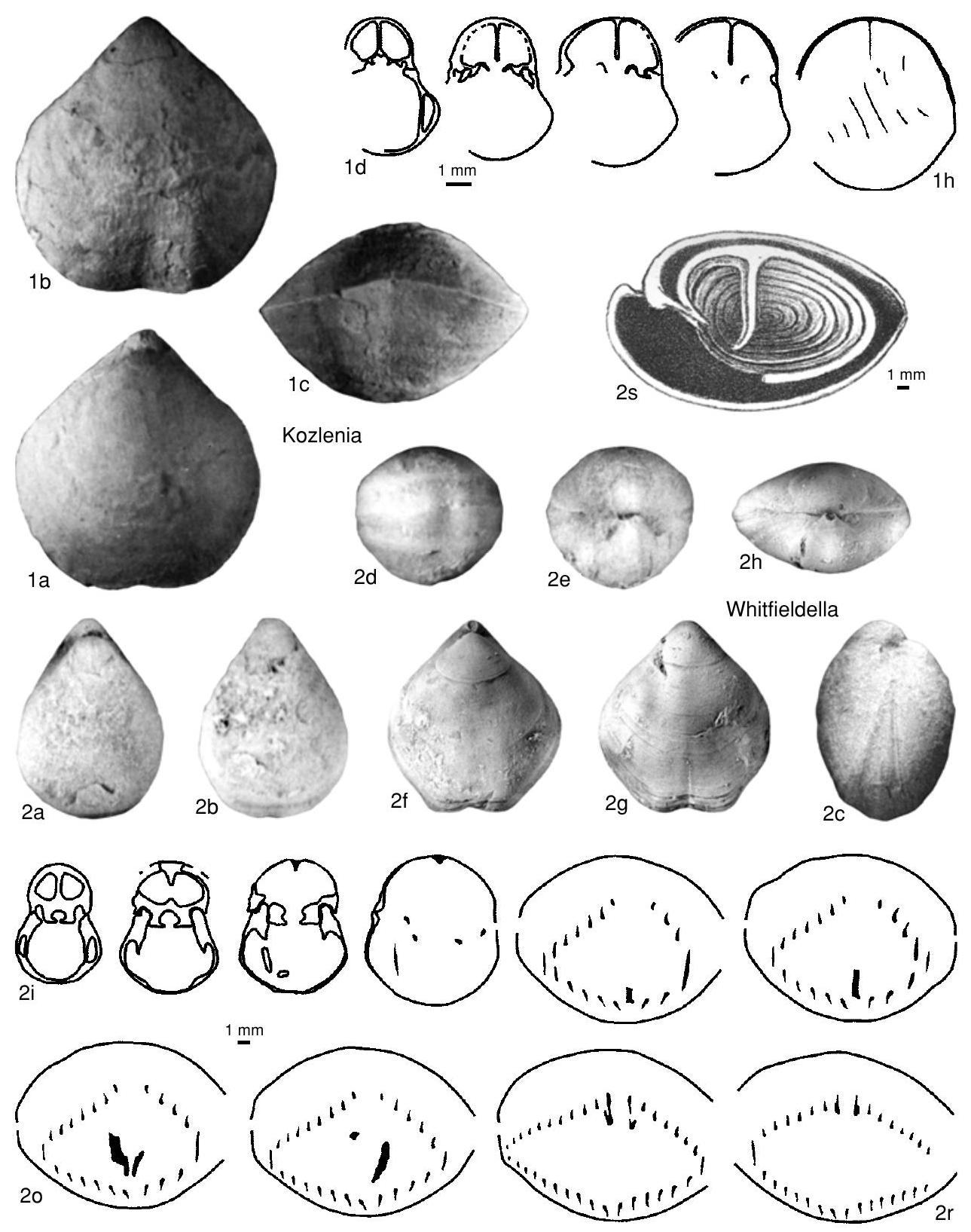Welcome to the Treatise on Invertebrate Paleontology!
Please enter a genera name to retrieve more information.

Whitfieldella
Classification
Phylum:
Brachiopoda
Subphylum:
Rhynchonelliformea
Class:
Rhynchonellata
Order:
Athyridida
Suborder:
Athyrididina
Superfamily:
Meristelloidea
Family:
Meristellidae
Subfamily:
Whitfieldellinae
Formal Genus Name and Reference:
Whitfieldella Hall & CLARKE, 1893, p. 58
Type Species:
Atrypa nitida HALL, 1843, Table 14, 5, OD (note that the figure on p. 12 is erroneously numbered as 13 when it should be 14, see Hall figure explanations)
Images
(Click to enlarge in a new window)
Fig. 1066, 2a-s. *W. nitida (Hall), Silurian, New York, USA, a-e, lectotype, dorsal, ventral, lateral, anterior, and posterior views, AMNH 31290, Hall collection, x3, f - h, dorsal, ventral, and posterior views, AMNH 40799, Hall collection, x1 (Alvarez & Brime, 2000), i-r, transverse serial sections 2.9, 3.1, 3.5, 4.6, 7.5, 7.6, 8.1, 8.4, 9.3, 10.5 ~mm from ventral umbo, GSC 98796 (adapted from Jin, Caldwell, & Norford, 1993), s, lateral view showing jugum (Glass, 1882).
Synonyms
Geographic Distribution
south-central USA, Tadzhikistan, southwestern China (Guizhou), Ashgill; North America, Europe, Siberia, southern China, Silurian; North America, ?Lochkovian.
Age Range
Beginning Stage in Treatise Usage:
Upper Ordovician (Ashgill)
Beginning International Stage:
Katian
Fraction Up In Beginning Stage:
66.7
Beginning Date:
447.72
Ending Stage in Treatise Usage:
Silurian, Lower Devonian (?Lochkovian)
Ending International Stage:
Lochkovian
Fraction Up In Ending Stage:
100
Ending Date:
412.4
Description
Biconvex, elongate trigonal to subpentagonal, with or without faint sulcus on both valves, lateral branches of jugum originating at approximately midlength of dorsal valve, vertical or projecting backward at high angle.
References
Museum or Author Information
Classification
Phylum:
Brachiopoda
Subphylum:
Rhynchonelliformea
Class:
Rhynchonellata
Order:
Athyridida
Suborder:
Athyrididina
Superfamily:
Meristelloidea
Family:
Meristellidae
Subfamily:
Whitfieldellinae
Formal Genus Name and Reference:
Whitfieldella Hall & CLARKE, 1893, p. 58
Type Species:
Atrypa nitida HALL, 1843, Table 14, 5, OD (note that the figure on p. 12 is erroneously numbered as 13 when it should be 14, see Hall figure explanations)
Images
(Click to enlarge in a new window)
Fig. 1066, 2a-s. *W. nitida (Hall), Silurian, New York, USA, a-e, lectotype, dorsal, ventral, lateral, anterior, and posterior views, AMNH 31290, Hall collection, x3, f - h, dorsal, ventral, and posterior views, AMNH 40799, Hall collection, x1 (Alvarez & Brime, 2000), i-r, transverse serial sections 2.9, 3.1, 3.5, 4.6, 7.5, 7.6, 8.1, 8.4, 9.3, 10.5 ~mm from ventral umbo, GSC 98796 (adapted from Jin, Caldwell, & Norford, 1993), s, lateral view showing jugum (Glass, 1882).
Synonyms
Geographic Distribution
south-central USA, Tadzhikistan, southwestern China (Guizhou), Ashgill; North America, Europe, Siberia, southern China, Silurian; North America, ?Lochkovian.
Age Range
Beginning Stage in Treatise Usage:
Upper Ordovician (Ashgill)
Beginning International Stage:
Katian
Fraction Up In Beginning Stage:
66.7
Beginning Date:
447.72
Ending Stage in Treatise Usage:
Silurian, Lower Devonian (?Lochkovian)
Ending International Stage:
Lochkovian
Fraction Up In Ending Stage:
100
Ending Date:
412.4
Description
Biconvex, elongate trigonal to subpentagonal, with or without faint sulcus on both valves, lateral branches of jugum originating at approximately midlength of dorsal valve, vertical or projecting backward at high angle.
